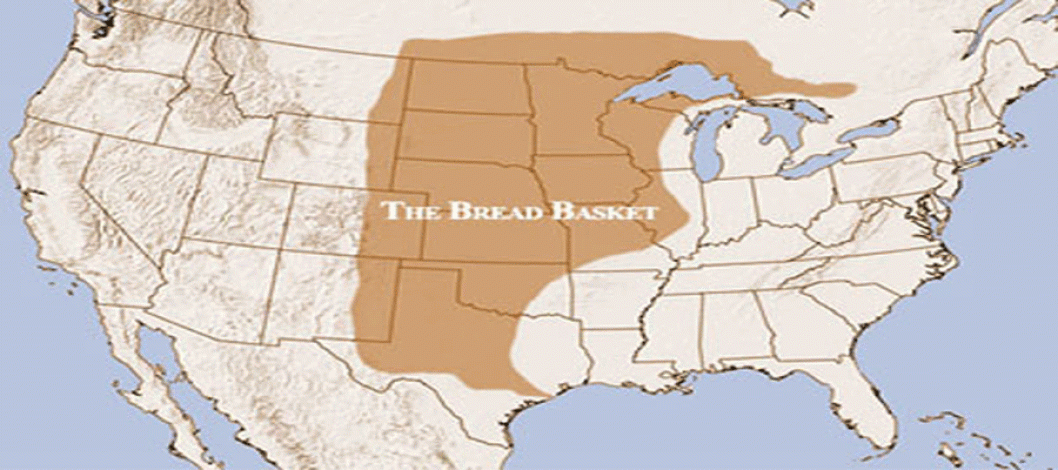
File Photo
The breadbasket of a country or region refers to an area where large quantities of wheat or other grains are produced due to the richness of the soil and/or favorable climate. Similarly, the term rice bowl is used to refer to Southeast Asia, and the Salinas Valley in California is sometimes referred to as the Salad Bowl of America. Such areas can be the subject of fierce political disputes that can even escalate into full-scale military conflict.
Breadbaskets have become important within the global food system, concentrating global food production in a small number of countries and (in countries such as India) in small geographic areas. As climate change increases weather variability around the world, the likelihood of multiple breadbaskets failing at the same time increases dramatically. The 2022 food crisis was partly facilitated by a series of failures in key breadbasket regions, while the Russian invasion of Ukraine in 2022 caused significant potential disruption to related breadbasket regions that are important for global wheat and oilseed production.
Sicily and Africa were considered the breadbasket of the Roman Republic. Later, Egypt was considered the breadbasket of the Roman Empire. Crimea was the source of a large amount of grain supplied to the Greek city-states, especially Athens. Similarly, in both India and China, each empire had a significant source of grain concentrated in a specific geographical area. The decline of the Roman Empire was partly due to the decline of the secure grain trade from Egypt.
In Canada, a major grain-producing area is called the Canadian Prairies. Sometimes, the province of Saskatchewan, also known for its large supplementary production of potash, is further distinguished from this region as Canada's main breadbasket.
In the United States, an important region is the Corn Belt, where corn and soybeans are the main crops, generally extending from the Great Lakes south to Missouri. In the west of both the United States and Canada, east of the Rocky Mountains, is the Wheat Belt, where the climate is too severe for corn or soybeans.
File Photo
In addition, the San Joaquin Valley in California is also called the Breadbasket of the World. The San Joaquin Valley produces most of the 12.8% of the United States' agricultural output (measured by dollar value) that comes from California. Grapes—table, raisins, and to a lesser extent, wine—are perhaps the valley's highest-profile products, but equally important (if not more so) are cotton, nuts (especially almonds and pistachios), citrus, and vegetables. 70% of the world's and 100% of the U.S. nut supply comes from the valley. Oranges, peaches, garlic, tangerines, tomatoes, kiwi, hay, alfalfa, and numerous other crops are harvested with great success. Nine of the top 10 and 12 of the top 20 producing counties in the country are in California, according to the 2002 Census of Agriculture's market value rankings of agricultural products sold.
During the 19th and 20th centuries, Argentina was known as the breadbasket of the world, due to the importance of agriculture in the country, and still is. Argentina's cereal crops are found in the Pampas region, which encompasses the provinces of Buenos Aires, Santa Fe, Córdoba, and La Pampa. Within this region, many cities, such as Pergamino, Venado Tuerto, and Rosario, are among the most fertile areas on the continent. Some of the crops grown include soybeans, corn, wheat, barley, sunflowers, and peanuts.
In the 19th century, access to the Californian and Australian markets made wheat exports a very profitable activity, leading to the Chilean wheat boom. In the mid-19th century, these countries experienced major gold rushes, which created a large demand for wheat. Chile was "the only wheat producer in the Pacific" at the time.
Brazil is also seen as a breadbasket, as it is the world's largest coffee supplier and has a vast area of arable land.
Wheat is a major crop grown in countries across Asia, Africa, Europe, Australia, and South America. While the wheat-producing regions of those regions are often referred to as the "breadbasket," it is more appropriate to call the "prairies" of North America, which include the United States and Canada, the "breadbasket."
-SZK
Comment Now